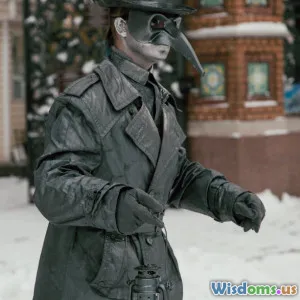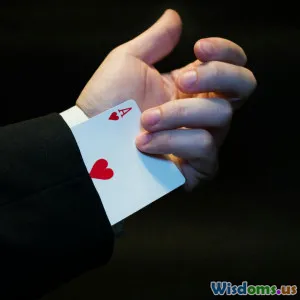
How to Train for Realistic Handcuff Escape Performances
17 min read Discover practical techniques and safety tips for mastering handcuff escape performances with a focus on realism and skill development. (0 Reviews)
Unlocking the Secrets: How to Train for Realistic Handcuff Escape Performances
Escape artistry has fascinated audiences for centuries, elevating ordinary shows into riveting displays of ingenuity and bravery. Among the most iconic illusions is the handcuff escape—a staple of both classic and modern performances. Mastering this craft requires more than quick fingers; it demands careful preparation, respect for safety, and in-depth knowledge of both technique and psychology. Whether you aspire to dazzle a stage audience or simply explore the secretive world of escapes, this guide will help you forge those critical skills for credible, amazing handcuff escapes.
Understanding Handcuffs and Their Mechanisms

Before any serious escape training can begin, it's crucial to understand the variety of handcuffs used by law enforcement and magicians. Not all handcuffs are created equal. Differences in design, make, and security mechanisms affect the methods and tools needed for a successful escape.
The Basics: Types of Handcuffs
- Chain Handcuffs: These feature a short chain linking the cuffs, offering the most flexibility in movement. Popular in North America, they're the most common type used in escape acts.
- Hinged Handcuffs: Here, the cuffs are joined by a solid hinge, restricting movement and making escapes much more challenging.
- Rigid Handcuffs: Known as "solid bar" cuffs, these allow almost no give between the wrists, commonly found in the UK and used for higher security.
- Thumbcuffs and Novelty Restraints: While less common, these can be included in performance for variety or additional difficulty.
Key Mechanisms and Security Features
Modern handcuffs generally share two locking mechanisms:
- Standard Lock: Controlled with a universal handcuff key. Simple, but not foolproof.
- Double Lock Mechanism: Prevents the cuff from tightening further or being quickly picked open. Always active in law enforcement contexts.
- High-Security Models: Some variants like the ASP Ultra or Smith & Wesson Model 1A use special keys, hidden pins, or anti-shim disks.
Example: Houdini famously escaped several specially-commissioned, high-security handcuffs in the early 1900s, enhancing his reputation not only for skill but also for a deep technical knowledge of the devices he faced.
Study real handcuffs in person if possible; discovering differences is key. Many escape artists keep a dedicated collection for practice and study.
Practicing Basic Opening Techniques

Handcuff escapes traditionally fall into a few core categories: leveraging knowledge of locks, physical dexterity, misdirection, and technique. No matter your approach, regular and disciplined practice is the foundation of excellence.
Learning to Use the Handcuff Key
The easiest method is, of course, using the actual key—often in a clandestine or highly skilled way. Performers may conceal keys in their hair, clothing, mouth, or props, making retrieval and use invisibly fast. Training to retrieve and use a key without drawing attention is an art in itself.
Drills for Discreet Key Use
- Speed Drills: Time yourself retrieving a key from different hiding spots and unlocking the cuffs behind your back.
- Blind Training: Practice unlocking while blindfolded; this develops dexterity and muscle memory.
- Misdirection Practice: Work on blocking audiences’ sightlines using body position or objects, increasing the realism of the illusion.
Tip: Start by practicing with your hands in front, then gradually move to unlocking them behind your back, under your legs, and eventually in more challenging positions.
Advanced Techniques: Picking and Shimming
- Lock Picking: Using a tension bar and simple pick, you can manipulate standard locks open. This takes time, as mechanisms are small and movement restricted.
- Shimming: Thin metal shims can slide into the cuff's ratchet to disengage the locking arm. Many law enforcement cuffs have anti-shim designs, but practicing on a range of models will soon reveal what works.
Safety First: Always keep a real key readily accessible or ensure a spotter can free you instantly during practice sessions. Practice cuffs are recommended until your skills are reliable.
Conditioning Flexibility, Dexterity, and Endurance

Physical conditioning makes a difference between awkward fumbles and seemingly effortless escapes. Flexibility and toughness—in both bodies and minds—build the resilience needed for thrilling performances that border on the impossible.
Hand and Wrist Flexibility
- Stretching Drills: Daily wrist circles, finger stretches, and forearm bends improve manipulation of keys or tools in cramped or constrained positions.
- Grip Strengthening: Squeezing a tennis ball or grip trainer amplifies control, especially helpful when hands are cuffed behind the back or placed under tension.
Real-World Practice Scenarios
Try these challenges for increased realism:
- Wet Hands: Wetness replicates stress and real-world conditions where friction is lost.
- Limited Lighting: Practice escapes in dim lighting or with fluctuating spotlights to adapt to stage conditions.
- Time Challenges: Use a stopwatch to gradually reduce escape times. Escapologist Steve Santini—famous for his speed and technical skill—attributes much of his mastery to timed drill repetitions under pressure.
Mind-Body Synergy
Mental conditioning matters as much as physical technique. Regular meditation or focus exercises help you stay calm under pressure, which is key to escaping when adrenaline surges and nerves vibrate. The confidence gained from thorough repeated training inspires audience trust.
Safety Protocols and Smart Training Environments

An authentic handcuff escape demands adherence to rigorous safety protocols. Practicing these stunts without regard for personal well-being has led to injuries and even fatalities, both historically and recently.
Golden Rules for Safe Practice
- Never Train Alone: Always have a knowledgeable spotter with a key and first aid nearby. Legendary magician Dorothy Dietrich, known for her bold stunts, always worked with an experienced assistant.
- Gradual Progression: Begin with hands in front, slowly adding difficulty with position (behind hips, under a bench, etc.) as confidence grows.
- Regular Equipment Checks: Examine cuffs for defects. Cheap or old devices can jam, trapping or injuring wrists with surprising ease.
Creating a Controlled Practice Space
- Clear Area: Ensure you have space to move without bumping into hazardous objects.
- Prearranged Signals: Develop a system with your assistant—or audience, if performing publicly—for emergencies. A vocal or physical cue can trigger an immediate intervention.
- First Aid Know-How: Minor abrasions, bruises, and pinched skin are frequent. Training sessions must keep basic supplies on hand.
Fact: A surprising number of early escape artists suffered permanent wrist injuries from chronic misuse of restrictive equipment. Consulting with a medical professional or physical therapist is always wise for sustained practice.
Incorporating Misdirection and Showmanship

Technical skill alone won’t make your escape memorable or believable. Showmanship—using storytelling, misdirection, timing, and emotional engagement—is what transforms a mechanical feat into entertainment. Master magician Harry Houdini captivated crowds not by sheer speed alone, but by creating suspense and drama with every movement.
The Art of Misdirection
Skillful escape artists combine overt struggle with covert action:
- Redirection of Attention: Create distractions with dramatic gesture or conversation. Penn & Teller, for example, are celebrated for their comedy-punctuated escapes that never quite happen as expected.
- Deceptive Clothing and Props: Fake sleeves, loose jackets, and modified cuff pouches conceal tools and enhance credibility.
- The Power of Pause: Contrived moments of failure can heighten suspense. Deliberate hesitation lets the audience doubt, then marvel at your triumphant release.
Unifying Theme and Presentation
Consider adding a backstory—perhaps involving a mystery or challenge—to deepen the experience. The escapology performances of Dorothy Dietrich and David Straitjacket are lauded not just for expertise, but also for the emotional journeys framing each escape: will the performer make it out in time, and what will happen if they don’t?
Developing Advanced Escape Skills

Once basics are mastered, push your boundaries with more challenging escapes. Advanced techniques involve
- Manipulating High-Security Cuffs: Scheduling time to experiment with less common police and custom handcuffs broadens your repertoire. Collect both old-fashioned, simple models and current high-security options.
- Double-Locking Under Stress: Modern law enforcement always double-locks cuffs to prevent movement. Mastering the opening of these (especially behind your back or with non-dominant hands) is highly valued. Specialized picks or shims may be required.
- Building and Using Custom Tools: Some artists fabricate tools disguised as clothing accoutrements—belt buckles, hairpins, buttons—that function as picks or keys. Chappy Brazil famously used a modified hair stick as a pick in early 20th-century acts.
- Multiple Layer Escapes: Link challenges such as being cuffed, locked in a box, or submerged in water. Legendary escapes often involve surmounting more than one restraint.
Setting Personal Challenges
Push your skills by setting goals:
- Freeing yourself in under a certain time, or from higher-security cuffs.
- Escaping while seated, upside down, or otherwise disoriented.
- Escaping from multiple cuffs or chained cuffs, as mock-police routines sometimes use.
The more you build diverse skills, the more you adjust your persona, narrative, and set pieces for truly unique performances.
Crafting the Audience Experience: Building Suspense and Engagement

Escapes resonate when every moment is crafted to draw emotional investment from your audience. Think critically about how your routine unfolds on stage.
Constructing Suspenseful Beats
- Imposed Time Limits: Add a ticking clock or countdown timer—either projected or audibly ticking. This ramps up tension, as famously employed by David Copperfield in televised escape specials.
- Physical Obstacles: Simulate real consequences (water rising, flames approaching) or have volunteers actively restrain you.
- Audience Participation: Bring someone on stage to examine cuffs, apply the restraints, and confirm the reality of your challenge.
Managing Mistakes and Variables
Not every escape goes perfectly. Part of a realistic performance is managing the unexpected. Deliberate or genuine stumbles—repeated failed attempts, visible frustration—can increase credibility before a final escape stuns the room.
Professional Standard: Ethical Considerations
- Do Not Imitate Law Enforcement Operations: While realism is exciting, never endanger yourself or others by copying unsafe or illegal scenarios (e.g., faked jail breaks, impersonation).
- Explain the Stunt (When Appropriate): Especially when performing for younger or impressionable audiences, talk about the skill and safety so no one tries to copy dangerous acts without training.
Essential Resources and Community Connections

Progress as a handcuff escape artist is faster and more enjoyable we see others’ work and get feedback.
Suggested Reading and Study Material
- "Modern Handcuff Secrets" by David De-Val
- "The Complete Escapologist" by Steven Santini
- "The Safest Escape" by Chris Gower
- Public domain writings of Harry Houdini, found on Project Gutenberg, offer deep dives into his approach and psychology.
Online and Local Communities
Magician clubs (such as the International Brotherhood of Magicians or The Society of American Magicians) often feature escapology workshops. Magic conventions routinely host panels on technique, history, and ethics.
- Escape Artist Forums and Workshops: Groups like Escape Masters and professional newsletters keep you abreast of new tricks, safety bulletins, and legal updates.
- Mentorship: Seek advice from advanced practitioners—many are happy to guide respectful beginners. Build your own network, sharing tips, videos, and equipment recommendations.
Bringing it All Together for Unforgettable Escapes

Training for realistic handcuff escape acts is a dynamic process that integrates technical prowess, physical discipline, and engrossing performance. Through diligent study of locks and practice in handling cuffs, you build a foundation of credibility. By nurturing dexterity, flexibility, and safety awareness, you add resilience and longevity to your career. The integration of storytelling, misdirection, and creative constraints on stage ensure that escapes don’t just impress—they truly entrance.
With each performance, you not only master an age-old art but also create moments of authentic astonishment. Take every escape, every rehearsal, and every lesson in showmanship as a stepping stone toward a more convincing and exhilarating act—one that will live on in the memories of your audiences long after the cuffs have dropped.
Rate the Post
User Reviews
Other posts in Famous Magical Feats and Records
Popular Posts















